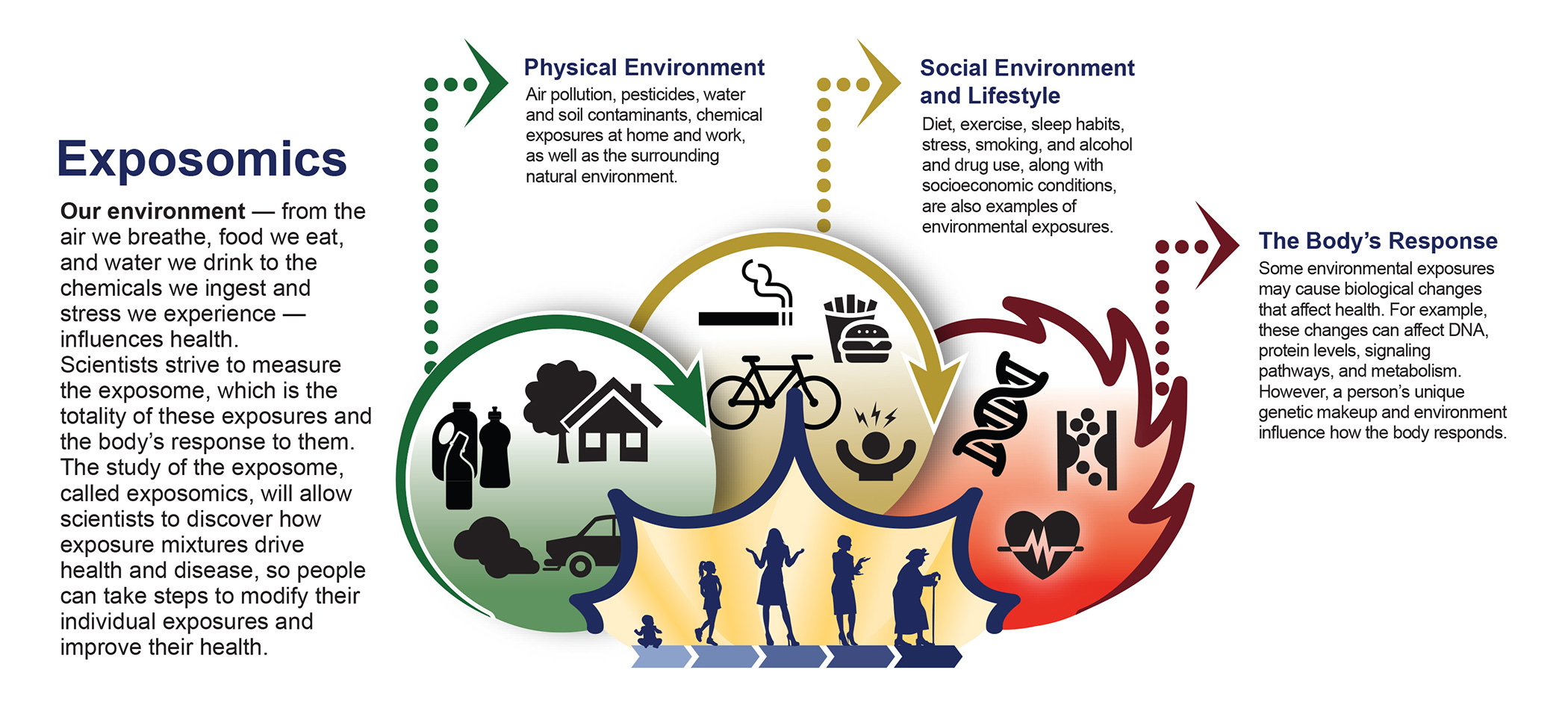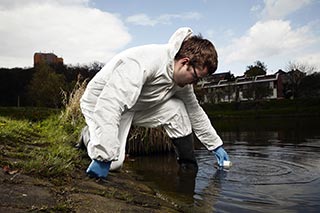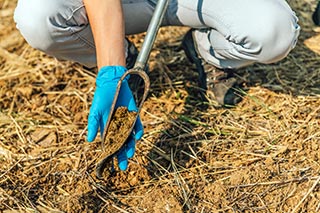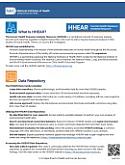Introduction

Exposure science is the study of our contact, such as by swallowing, breathing, or touching, with environmental factors and their effects on the human body. Research in this field aims to determine the types, levels, and combinations of exposures people experience and how those exposures affect human health and disease over a lifetime.
Environmental exposures can be external factors such as sunlight, chemical pollutants, diet, and social interactions, or internal factors, such as stress or metabolism. One simple way of thinking about the environment is that everything that is not determined by your genes is determined by your environment.
Scientists seek to better understand how various types of exposures are transported across land, air, and water and, upon contact with people, transformed within our bodies. Scientists also seek to understand how these exposures affect our chance of developing disease.
Their research approaches have steadily improved over time. For example, innovative sensors are now available to measure real-time exposure to environmental chemicals and track lifestyle factors such as diet and exercise. High-tech, predictive computer modeling can simulate external and internal exposure conditions. Exposure levels can be measured in bodily fluids and tissues such as blood, hair, urine, and even teeth.
What Is the Exposome and Exposomics?
The exposome is the totality of all environmental exposures and our body’s response to those exposures across the lifespan. Understanding the human exposome is important because many health conditions, such as cancer, cardiovascular disease, and diabetes, may result from multiple and varied environmental exposures over time, as well as interactions between certain exposures and genes.
Exposomics is the transdisciplinary study of the exposome. "Omics" refers to the collective technologies used to explore the roles, relationships, and actions of various types of molecules that make up the cells of an organism.
Exposomics is a field that considers the comprehensive and cumulative effect of physical, chemical, biological, and (psycho)social mediators on biological systems. Scientists in this field integrate data from a variety of interdisciplinary methodologies and sources to analyze environmental influences on health.
While researchers know the structure of human genes, collectively called the genome, they have yet to characterize the totality of the human exposome.

What is NIEHS Doing?
At the forefront of exposure research for decades, NIEHS is accelerating its scientific and technological achievements to tackle a complete characterization of the exposome. This effort requires coordinating multiple disciplines including exposure science, toxicology, informatics, sensor and -omics technology, and environmental epidemiology.
NIEHS funds researchers who established the HERCULES Center (Health and Exposome Research Center: Understanding Lifetime Exposures), located at Emory University. It is the first exposome-based research center in the United States. The HERCULES Center aims to promote the concept of the human exposome project on both a national and international level. More information is available about the center and exposome research.
Sensors and Other Technologies
NIEHS supports development of sensors and other technologies to assess personal exposure in real time, with non-wearable or wearable monitors. These products measure exposure with high sensitivity and specificity, and low cost. NIEHS is particularly interested in personal sensors that measure multiple chemicals simultaneously or pair exposure assessment with physiological response. The following are a few examples of the technologies NIEHS has funded:
- Wristbands to measure airborne toxic chemicals – Researchers at Oregon State University developed simple silicone wristbands to capture and measure a large number of diverse compounds at environmentally relevant concentrations.1 The wristbands have been used to study personal exposures to organic compounds, like mold, following Hurricane Harvey, pesticide exposures in West Africa, and to uncover links between flame retardant exposure and social behaviors in children.
- Air pollution and exercise – Researchers at RTI International developed the MicroPEM to measure human exposure to a type of air pollution called particulate matter.2 The tool combines data from instruments that measure particulate matter concentrations every minute, with estimates of how much air a given person draws into their lungs during exercise such as cycling. Researchers at Columbia University are using this sensor, with other devices that monitor physiological responses in real time, to find out at what point the harm done by pollution might outweigh health benefits gained from exercise.
- Testing airborne toxic air pollution – Colorado State researchers developed the Automated Microenvironmental Air Sampler to quantify airborne toxic particles.3 This wearable device can assess air pollution exposure in different “microenvironments,” such as home and school. As the people who wear the devices move through their day, researchers can determine the type of microenvironment through sensors that detect GPS location, light, temperature, or atmospheric pressure.
- Exposure to ultrafine particles – Researchers at Cincinnati Children’s Hospital Medical Center developed a device that measures personal exposure to ultrafine particles, a type of air pollution in motor-vehicle exhaust.4 The researchers used this sensor to characterize short-term and peak exposure to ultrafine particles among adolescents–about a third of whom are asthmatic–and gauge effects on lung function.
- Identifying air pollution components – Columbia University researchers, in partnership with the San Francisco-based company AethLabs, developed the microAeth monitor to measure particulate matter. The monitor enables identification of particle types, such as black carbon, tobacco smoke, or wood smoke, in air pollution exposures.5

Small Business Innovation Research (SBIR) Grants and Small Business Technology Transfer Research (STTR) Grants – NIEHS SBIR/STTR grants help small businesses develop innovative and commercially viable products or technologies to improve public health. Promising products include the following:
- Monitoring ozone – 2B Technologies’ Personal Ozone Monitor is a hand-held device that uses UV-sensing technology for a variety of personal-exposure monitoring applications, such as health effects of air pollutants, health and safety at industrial sites, or long-term observation at remote locations where power is limited.
- Testing heavy metals in water – ANDalyze’s water-quality sensors use proprietary DNA technology to detect and quantify toxic heavy metals in water. This technology can be used to test community water supplies, ground or well water, or wastewater recycling.
- Sensing chemicals in aerosols and other products – TF Health’s personal monitor tracks exposure to volatile organic compounds, which arechemicals containing carbon that are found in many consumer products such as hair spray, aerosol perfumes, cleaning agents, and paints. The device is wearable and can be paired with a smartphone app to visualize exposure levels.
- Classroom sensor programs – AQTreks designed a school-based program using portable Personal Air Monitors (PAM) in which students can measure air pollutants, view real-time data on their smartphones, and analyze exposure data in classrooms. The PAM measures carbon monoxide, carbon dioxide, particulate matter, temperature, and humidity.
- Measuring contaminated sites – The small business, Picoyune, a spin-off company from the University of California, Berkeley Superfund Research Program Center, developed a portable detector to measure mercury in soils, sediments, and air. It is particularly useful at contaminated sites.
- Testing airborne chemicals – Entanglement Technologies created the Autonomous Rugged Optical Multi-gas Analyzer (AROMA-TCE) to measure trace concentrations of trichloroethylene, a colorless liquid that evaporates easily in air can pollute water and soil. AROMA-TCE is small enough to fit in vehicles and can perform rapid field tests. It was used to measure trichloroethylene after Hurricane Harvey in Houston.
- Testing lead in tap water – NanoAffix Science, with a grant from the Superfund Research Program, is working on a handheld device for real-time, on-site detection of lead in tap water.

Superfund Research Program (SRP) – NIEHS SRP supports development of sensors for monitoring and detecting hazardous substances in the environment, including these:
- Investigating polychlorinated biphenyls – Researchers at the University of Iowa SRP Center developed a method to measure the movement of polychlorinated biphenyls (PCBs) from water to air using passive sampling devices.
- Testing contaminants in urine – A new tool and method that provides an easy way to extract substances from urine was developed by researchers at the Northeastern University SRP Center. It can reveal many substances not naturally produced or expected to be present in the human body, called xenobiotics, from a sample of urine.
- Detecting environmental chemicals – A new low-cost portable device uses a smart phone to detect the presence and concentrations of BDE-47 (2,2',4,4'-tetrabromodiphenyl ether), a type of flame retardant and widespread environmental contaminant. The device, developed by researchers at the University of California-Davis SRP Center, uses a lab-on-a-chip platform and antibodies to measure a specific substance in a sample.
- Testing poly‐ and per-fluorinated alkyl substances (PFAS) in the field – Researchers at the University of Rhode Island SRP center developed a sampling tool for detecting PFAS precursors in air and water.6
The Personalized Environment and Genes Study (PEGS) integrates genetic and environmental data to understand disease etiology, identify disease risk factors, and improve disease prevention. The goal of PEGS is to integrate large-scale, multi-dimensional data and enable researchers to discover the causes of diseases and identify the collective effects of environment, diet, lifestyle, and genetic factors on human health.
While most studies focus on a single disease or environmental exposure, PEGS collects data on multiple diseases and environmental exposures, along with information about diet and lifestyle and genetic data. This North Carolina-based study has extensive data, including both questionnaire-based and geospatial estimates of exposome-wide environmental exposures, whole genome sequencing, and linkage to electronic health records.
Fact Sheets
HHEAR Handout
The Human Health Exposure Analysis Resource (HHEAR) is a centralized network of exposure analysis services and expertise available to eligible researchers who want to add or expand exposure analysis to their studies of human health. There is no cost to the investigator.
HHEAR is a partnership spanning the National Institutes of Health (NIH), funded by the National Institute of Environmental Health Sciences; the National Cancer Institute; the National Heart, Lung, and Blood Institute; and the NIH Environmental Influences on Child Health Outcomes Program.
-
Anderson KA, Points GL, Donald CE, Dixon HM, Scott RP, Wilson G, Tidwell LG, Hoffman PD, Herbstman JB, O'Connell SG. 2017. Preparation and performance features of wristband samplers and considerations for chemical exposure assessment. J Expo Sci Environ Epidemiol 27(6): 551-559. doi: 10.1038/jes.2017.9. [Abstract Anderson KA, Points GL, Donald CE, Dixon HM, Scott RP, Wilson G, Tidwell LG, Hoffman PD, Herbstman JB, O'Connell SG. 2017. Preparation and performance features of wristband samplers and considerations for chemical exposure assessment. J Expo Sci Environ Epidemiol 27(6): 551-559. doi: 10.1038/jes.2017.9.]
-
Yan B, Pitiranggon M, Ross J, Arthen-Engeland T, Stelter A, Chillrud SN. 2018. Validation of Miniaturized Particulate-Matter Real-Time Samplers for Characterizing Personal Polycyclic Aromatic Hydrocarbon Exposure. J Anal Bioanal Tech, 9(2), 403. doi:10.4172/2155-9872.1000403. [Abstract Yan B, Pitiranggon M, Ross J, Arthen-Engeland T, Stelter A, Chillrud SN. 2018. Validation of Miniaturized Particulate-Matter Real-Time Samplers for Characterizing Personal Polycyclic Aromatic Hydrocarbon Exposure. J Anal Bioanal Tech, 9(2), 403. doi:10.4172/2155-9872.1000403.]
-
Quinn C, Miller-Lionberg DD, Klunder KJ, Kwon J, Noth EM, Mehaffy J, Leith D, Magzamen S, Hammond SK, Henry CS, Volckens J. 2018. Personal Exposure to PM2.5 Black Carbon and Aerosol Oxidative Potential using an Automated Microenvironmental Aerosol Sampler (AMAS). Environ Sci Technol 52(19):11267-11275. doi: 10.1021/acs.est.8b02992. [Abstract Quinn C, Miller-Lionberg DD, Klunder KJ, Kwon J, Noth EM, Mehaffy J, Leith D, Magzamen S, Hammond SK, Henry CS, Volckens J. 2018. Personal Exposure to PM2.5 Black Carbon and Aerosol Oxidative Potential using an Automated Microenvironmental Aerosol Sampler (AMAS). Environ Sci Technol 52(19):11267-11275. doi: 10.1021/acs.est.8b02992.]
-
Leaffer D, Wolfe C, Doroff S, Gute D, Wang G, Ryan P. 2019. Wearable Ultrafine Particle and Noise Monitoring Sensors Jointly Measure Personal Co-Exposures in a Pediatric Population. Int J Environ Res Public Health. 16(3) doi: 10.3390/ijerph16030308. [Abstract Leaffer D, Wolfe C, Doroff S, Gute D, Wang G, Ryan P. 2019. Wearable Ultrafine Particle and Noise Monitoring Sensors Jointly Measure Personal Co-Exposures in a Pediatric Population. Int J Environ Res Public Health. 16(3) doi: 10.3390/ijerph16030308.]
-
Lovinsky-Desir S, Lawrence J, Jung KH, Rundle AG, Hoepner LA, Yan B, Perera F, Perzanowski MS, Miller RL, Chillrud SN. 2018. Assessment of exposure to air pollution in children: Determining whether wearing a personal monitor affects physical activity. Environ Res. 166:340-343. doi: 10.1016/j.envres.2018.06.017. [Abstract Lovinsky-Desir S, Lawrence J, Jung KH, Rundle AG, Hoepner LA, Yan B, Perera F, Perzanowski MS, Miller RL, Chillrud SN. 2018. Assessment of exposure to air pollution in children: Determining whether wearing a personal monitor affects physical activity. Environ Res. 166:340-343. doi: 10.1016/j.envres.2018.06.017.]
-
Dixon-Anderson E, Lohmann R. 2018. Field-testing polyethylene passive samplers for the detection of neutral polyfluorinated alkyl substances in air and water. Environ Toxicol Chem 37(12):3002-3010. doi: 10.1002/etc.4264 [Abstract Dixon-Anderson E, Lohmann R. 2018. Field-testing polyethylene passive samplers for the detection of neutral polyfluorinated alkyl substances in air and water. Environ Toxicol Chem 37(12):3002-3010. doi: 10.1002/etc.4264]
Further Reading
Stories from the Environmental Factor (NIEHS Newsletter)
- Environment Strongly Influences Chronic Disease Development (April 2025)
- Tiny Plastics, Big Questions: In Conversation with Dr. Matthew Campen (April 2025)
- Epingenetics and the Exposome: A New Era of Disease Prevention (February/March 2025)
- Sleep Health and Our Environment: A Conversation with Chandra Jackson (January 2025)
- First NIH-wide Exposome Research Coordinating Center Launched (October 2024)
- Data Science Event Showcases New Approaches to Environmental Health (May 2024)
- New Technology Detects Molecular Signatures That Can Predict Autism Risk (May 2024)
- Research Into Totality of Exposures – the Exposome – Advanced by NIEHS (January 2024)
- Burn Pits’ Complex Emissions Simulated in NIEHS Grantee’s Laboratory (December 2023)
- Light and Dark: Underappreciated Exposures With Big Effects on Health (November 2023)
- “All of Us” Study Adds Environmental Exposures (August 2023)
- Silicone Wristbands Track Hundreds of Unique Chemical Exposures (August 2023)
- Microplastics Research: Sum of Our Exposures Studied by Grantee (July 2023)
- Workshop Series Signals Turning Point for Exposome Research (September 2022)
- Pets Can Be Valuable Sentinels of Environmental Exposures (January 2022)
- Totality of Human Exposures, New Research Center Explored by Grantees (December 2021)
- Geospatial Data, Population Health Merge at NIEHS Workshop (July 2021)
- Paradigm Shift Needed in Environmental Health Sciences (March 2021)
- Data Science May Resolve How Environment Influences Disease (January 2021)
Podcasts
- Understanding Exposures to Microplastics and Nanoplastics (September 2024) - NIEHS-funded scientist Phoebe Stapleton, Ph.D., assistant professor in the Rutgers University Department of Pharmacology and Toxicology, talks about her research to track the movement and potential health effects of micro- and nanoplastics in the body.
- The Exposome and Health (Part 1) (July 2023) – Douglas Walker, Ph.D., of Emory University, discusses how the field of exposomics is transforming environmental health research. He also talks about challenges in the field and opportunities for exposomic research to improve public health.
Additional Resources
- Advancing Social Determinants of Health Research at NIH Through Cross-Cutting Collaboration (2023) – This blog post from the director of the National Institute of Nursing Research describes how social determinants of health are an increasingly high-priority research area for the National Institutes of Health. It helps explain the statement “Your ZIP code is more important to your health than your genetic code.”



